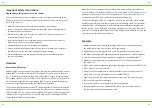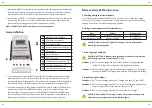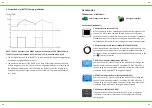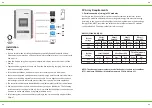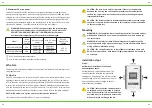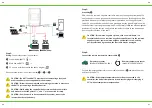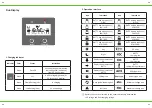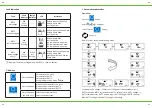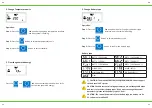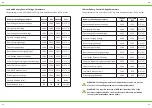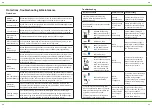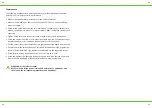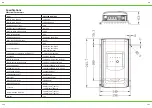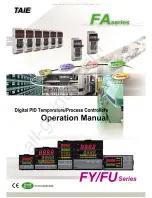
EN
EN
84
85
2. Maximum PV array power
The MPPT controller has the function of charging current/power-limiting, that is,
during the charging process, when the charging current or power exceeds the rated
charging current or power, the controller will automatically limit the charging current
or power to the rated value, which can effectively protect the charging parts of the
controller, and prevent damages to the controller due to the connection of over-spe-
cification PV modules. The actual operation of PV array is as follows:
WARNING: When the power of PV is not greater than the rated charging
power, but the maximum open-circuit voltage of PV array is more than
60V(DR**06N-DDB/DDS)/100V(DR**10N-DDB/DDS)(at the lowest
environmental temperature), the controller may be damaged.
WARNING: Risk of explosion. Never install the controller in a sealed enclose
with flooded batteries. Do not install in a confined area where battery gas
can accumulate.
WARNING: Risk of electric shock. When wiring the solar modules, the PV
array can produce a high open circuit voltage, so turn off the breaker before
wiring and be careful when wiring.
Wire Size
The wiring and installation methods must conform to all national and local electrical
code requirements.
PV Wire Size
Since PV array output can vary due to the PV module size, connection method or sun-
light angle, the minimum wire size can be calculated by the Isc* of PV array. Please
refer to the value of Isc in the PV module specification. When PV modules are connected
in series, the Isc if equal to Isc of PV modules. When PV modules are connected in par-
allel, the Isc is equal to the sum of the PV modules’Isc. The Isc of the PV array must not
exceed the controller’s maximum PV input current. Please refer to the table as below:
NOTE: All PV modules in a given array are assumed to be identical.
*Isc=Short circuit current(amps) Voc= Open circuit voltage
Mounting
Installation steps
Step 1:
Determine of installation location and
heat-dissipation space.
Determination of installation location: The
controller shall be installed in a place with
sufficient air flow through the radiators of the
controller and minimum clearance of 150 mm
from the upper and lower edges to ensure
natural thermal convection.
① At 250C environment temperature.
② At minimum operating environment temperature.
Model
Rated
Charge
Current
Rated Charge
Power
Max. PV Array
Power
Max. PV
Open Circuit
Voltage
DR2210N-DDB/DDS
20A
260W/12V
520W/24V
390W/12V
780W/24V
92V
①
100V
②
DR3210N-DDB/DDS
30A
390W/12V
780W/24V
580W/12V
1170W/24V
CAUTION: The wire size is only for reference. If there is a long distance
between the PV array and the controller or between the controller and
the battery. Larger size wires can be used to reduce the voltage drop and
improve performance.
CAUTION: The battery cable size recommendations assume that the charge
controller is the only device connected to this cable (no inverter connected
to the same cable etc).
CAUTION: The controller requires at least 150mm of clearance above and
below for proper air flow. Ventilation is highly recommended if mounted in
an enclosure.
CAUTION: Ensure that the controller is able
to dissipate heat if it’s installed in a closed
area. If the controller is to be installed in an
enclosed box, it is important to ensure relia-
ble heat dissipation through the box.











